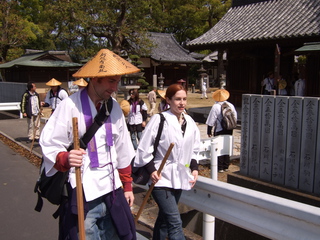24Apr10: Jessica Nettles
 The 88 Temple pilgrimage of Kobo Daishi is more than a tourist trap. It's one of the bits of Shikoku culture that residents soon find themselves as familiar with as udon or iyokan. Entire seasons seem incomplete without the tinkling of bells dangling from walking sticks and the sound of distant chanting. Just the sillouette of a white-garbed traveller in a wide sedge hat can inspire a twinge of respect or even charity. The spare coins in our wallets suddenly seem heavier at the sight of a pilgrim's begging bowl.
The 88 Temple pilgrimage of Kobo Daishi is more than a tourist trap. It's one of the bits of Shikoku culture that residents soon find themselves as familiar with as udon or iyokan. Entire seasons seem incomplete without the tinkling of bells dangling from walking sticks and the sound of distant chanting. Just the sillouette of a white-garbed traveller in a wide sedge hat can inspire a twinge of respect or even charity. The spare coins in our wallets suddenly seem heavier at the sight of a pilgrim's begging bowl.
As much a part of the fabric of my daily life the pilgrims have become, I had never walked in their shoes. I suppose I'd never even thought of it. To most people, walking the countryside to visit temples seems an antiquated form of torture. After all, we have trains and busses for that! But thanks to the efforts of several international exchange groups active in Kagawa Prefecture and the assistance of learned local guides, I was given a chance to walk part of the circuit as it was meant to be walked and get a glimpse of some of the more charming, hidden-away parts of the 88 Temple route.
We travelled from Motoyama Temple to Kaigan Temple on foot, in the company of friends old and new. At each temple we were met with friendly faces and helpful explanations. The historic buildings and sprawling grounds were made all the more intriguing with a context in which to place their architecture, statuary and incence-scented interiors. There is a wealth of history waiting to be uncovered by curious visitors.
The paths between the temples run through some of the most gorgeous, authentic countryside Kagawa has to offer. The road winds through rice paddies, mountains, lakes, streams, reservoirs, orchards, shrines and neighborhoods large and small... ocaisionally dissappearing altogether for a stretch of forest or a major highway. In each place we found all manner of wildlife. We saw ducks, turtles, hawks, lizards and songbirds at nearly every turn ~ some species unfamiliar to me. It's possible that some of them don't live in my home country, but it seems even more likely that I'd simply never paused along a forest-path long enough to appreciate them as they quietly went about their business overhead and underfoot.
The pilgrim trails twist through mountain and forest alike. Fallen trees bisect the path and streams carry it away here and there, leaving no doubt as to the extreme age of the half-buried stones underfoot. I found myself greatful for the company of a multitude of surprisingly well-tended statues the guardian boddhisattva Jizo dotting the path. Some were deliberately cleaned and cared for, decorated with cut flowers and small offerings. Others were being tended by nature itself, surrounded by more erratic sprays of wildflowers with offerings of acorn shells and fallen leaves. These statues and their remarkable variety of serene expressions are the surest way to be sure that you're still safe on the path to the next destination.
They say that when you walk the 88 Temple Pilgrimage, you walk with the Buddhist master who originated it: Kobo Daishi. Walking with purpose and contemplation, some may gain new perspective on our lives and the buddhist concerns of earthly suffering. But one need not have such lofty goals to enjoy the beauty to be had along the way. Walking the 88 isn't just "walking with Kobo Daishi", it's walking with Kagawa itself.
Jessica Nettles